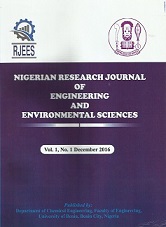Particle Overlay Obstruction Modelling, Parametric and Output Characteristics Evaluation of a Photovoltaic System
Authors: Ibeagwu OI, Eke MN, Maduabuchi CC, Mgbemene CA, Aka TV
DOI Info: N/A
ABSTRACT
This study theoretically investigated the obstruction models for overlaid dust particles on the surface of a Photovoltaic (PV) system. The models applied were the soiling overlay transmission models which was developed by NASA and Martin’s model. These models were capable of incorporating the various dust sizes and predict the effect of dust obstruction on the output characteristics and other necessary parameters of PV systems. Simulation was done using MATLAB software. The results were calculated and compared with existing experimental results. The investigated models facilitated the prediction of PV performance under dusty conditions for different particle sizes irrespective of the location. From the study, the dusty system has less transmissivity and more heat loss than the dust free system. The power output and efficiency of the PV system was found to have percentage losses of 20.9% and 9.1% respectively for a mass density of 7.91 kgm-2. The obstructed radiation influenced the current- voltage (I-V) characteristic under a dusty condition and it was observed that the adverse effect is also dependent on the type of dust. In comparison with experimental result in Karnataka, India, the maximum percentage deviation from the experimental result was 6.3% and 9% for the power loss and the current-voltage (I-V) characteristics.
Affiliations: Department of Mechanical Engineering University of Nigeria, Nsukka, Enugu State, Nigeria.
Keywords: Obstruction Transmission Models, Particle Overlay, PV System, Soiling, Power Output
Published date: 2020/12/30









